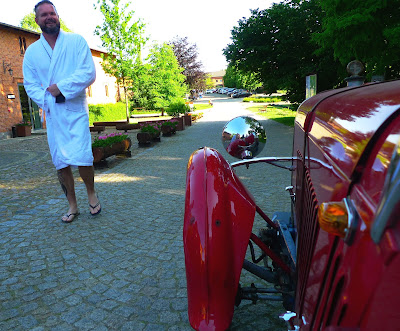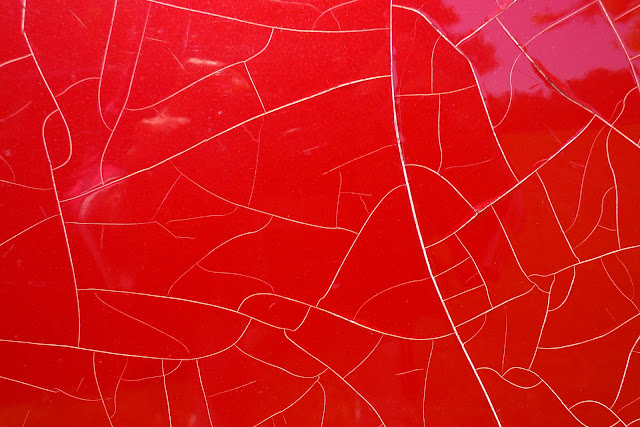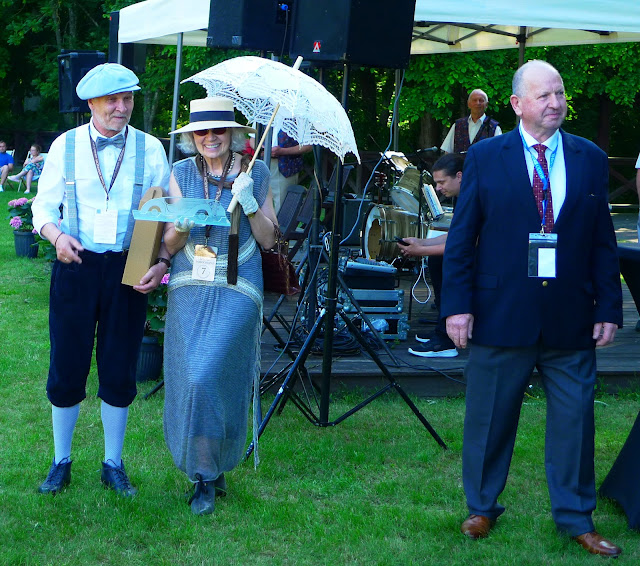 |
Classica Mierzęcin 12-15 June 2025
A little history of the venue first ! The
Neo-Gothic style palace building is surrounded by a large landscape park with
Arcadian features reminiscent of the English landscape garden designer William
Kent at Rousham. The Octagonal Tower dominates the façade; balconies are
decorated with balustrades and terracotta statues of eagles. The German
architect Friedrich Hitzig is said to have been the designer of the palace. On
the 9th of July 1998 the palace, together with the manor, was purchased by
NOVOL - a Polish car paint company. Between 1999 and 2001, thanks to the
generous efforts of the new owners, the palace was thoroughly renovated with
great artistic panache.
|
The RREC Polish Section at Classica Mierzęcin
Lt to Rt: 1935 Rolls-Royce Phantom II Hooper (153TA), 1949 Silver Wraith Park Ward Sport Saloon (WDC57), 1962 Bentley S3 Continental Drophead Coupé, 1974 Rolls-Royce Silver Shadow (SRH18723)
My more than 50 year old Rolls-Royce Silver Shadow had been serviced and coped
well with the long 480 kms drive from Warsaw to Mierzęcin. As it is the 60th
anniversary of this revolutionary design and a RREC Polish Section event I decided
in a carefree moment to drive rather than adopt the trailer-queen, weak-kneed option.
However, the vast trucks did succeed in terrifying me as they thundered towards
one taking up almost the entire width of one lane on a two-lane highway. An
amount of dual carriageway relieved the stress.
In
the Autumn of 1965 the most radical design for Rolls-Royce was revealed to the
public at the Paris Motor Show. Dealers caught their first glimpse of the car
on September 30th and October 1st. As you know, the Rolls-Royce Silver Shadow
(and the Bentley T Series) were designed by John Blatchley who produced a far more
compact design than the previous Silver Cloud but with at least as much
interior space.
Parked
beside the current models, the Shadow appears dainty and elegant
indeed, a car easy to use and manage (except parking!) in the
traffic conditions of 2025.
Being
of a monocoque construction with self-leveling suspension and disc brakes, it
marked the most significant departure in 60 years from the chassis
based, coach-built models of the past. From the outset it was
designed with the owner/driver in mind. Over a period of more than 10 years,
16,717 Silver Shadows and 1712 Bentley T-Series were produced making it the
most successful Rolls-Royce of all time. A much underestimated car
and a revolution at the time.
I
have owned mine for over 38 years and it remains completely original. This
magnificent vehicle has given me intense leisure experiences of many varieties
over the years. However, I will remain tactfully silent of my own detailed 'adventurous
history' with it.
The
original build sheets of my example, SRH 18723 from the Hunt House, which I treasure,
indicate that my car was completed on February 5th 1974.

The Badge Bar on the Silver Shadow (a guessing game!)
Classica Mierzęcin June 2025
 |
The 1933 Singer Nine Sports Special and the RREC Polish Section Chairman's
1949 Silver Wraith (WDC57) Park Ward Sport Saloon |
Thursday
12/VI/2025 was devoted to crew registration and registration of entries for the
Concours d'Elegance under the auspices of FIVA. There were a number of exceptional and valuable cars this year.
Here are a few ...
 |
Lt to Rt: On the trailer, 1935 Hooper Phantom II (153TA), superbly restored 1971 Buick Riviera, remarkable 1964 VW T1
Lt to Rt: 1965 Ford Mustang, 1965 Volvo P 1800, 1952 Willys Jeep M38A1
Lt to Rt: 1965 Volvo P 1800, meticulously restored 1987 Jaguar XJS-C V12
A magnificent 1952 Jaguar XK 120
1961 Jaguar Mk II followed by 1963 Buick Riviera |
 |
An astoundingly accurate detailed restored 1939 Tatra T-87 completed in the Czech Republic by the original factory engineer of this model
In the centre between the Tatra and the Rolls-Royce Wraith a
1939 Chevrolet Master Deluxe 85

A fabulous 1938 Horch 853 Sport Cabriolet
An extraordinary 1952 Willys Jeep M38A1 with authentic b/w pictures of Elvis Presley being instructed in its maintenance
A multiple award-winning Polish 1917 Buick D-4 (1922 Targa Florio, Le Mans ...)
A 1950 Hudson Commodore (there were many American cars at this event, especially Buick Rivieras) and 1952 Jaguar XK120
|
A superbly restored and rare (large capacity engine) 1960 Facel Vega HK 500 Excellence 1
A large bonfire and
barbecue dinner at the Grill Gazebo opened the event in the evening. We also took
advantage of the rare opportunity to indulge the decadent delights of a
'pop-up' drive-in cinema where Bonnie and Clyde was screened. In the
chill of evening, I thought this so cute, having visited these places in my
youth with the girl of the moment, a hamburger and a coke, the soundtrack speaker
attached to the car window frame.
 |
The rally assembled outside the new Philharmonia Concert Hall, Gorzów |
Friday
13/VI/2025 saw us gathering for a rally to the town of Gorzów. The drive of 56
kms was through forested parkland and agricultural country. This excursion was gloriously
picturesque, as if immersed in a gargantuan creation of Capability Brown. We
parked outside the new Philharmonia concert hall and took the greatest pleasure
in a rehearsal of the Mozart piano concerto No 20 in D Minor K466 with the well-known Polish
pianist Marcin Masecki.
 |

Marcin Masecki and the Gorzów Philharmonic Orchestra |
He is also a jazz player and interpolated jazz elements
into the concerto, especially the cadenzas which I found rather amusing and
most diverting. A charming alfresco lunch in the landscaped garden of the concert
hall was offered in conclusion.
We
returned to the Pałac via a similar green picturesque route. The evaluation of
vehicles entered in the FIVA Concours d'Elegance took place. To conclude
the day a stylish barbecue dinner pic-nic in the Pałac Mierzęcin vineyard (tasty
duck, steak or fish and superb Mierzęcin red or white wine gratis) with live music
from a guitarist.
 |
Picnic in the vineyard
The vineyard with a 1933 IHLE-DKW |
Saturday
14/VI/2025 was a Public Open Day. We had assembled our 'beloveds' together in
exhibition for the enthusiastic public in superb sunny weather. There were both
'Oldtimers' and 'Youngtimers' on exhibition in addition to a remarkable vintage
bicycles display and a period fashion show entitled 'Retromania'.
Throughout
we were treated to the music of an excellent Dixieland band concert. As
somewhat of a musical expert in these things, I can say they were all excellent
jazz musicians which I felt rather escaped the notice of the car-preoccupied parade
of onlookers.
 |
Wellness and classic cars go perfectly together to offer rare summer pleasure |
From
12:00-18:00 a special guest was the motoring encyclopedia Patryk Mikiciuk
who commented knowledgeably and entertainingly on the cars that passed
individually on a raised platform during the afternoon.

In May 2025, Rolls-Royce Motor Cars marked the centenary of the launch of the first New Phantom. Throughout its long history, the Phantom nameplate has been reserved for the pinnacle model in the marque’s portfolio – the very apex of excellence.
"One hundred years ago, Rolls-Royce launched the first motor car to bear what would become the most evocative and enduring nameplate in its history: Phantom. Through eight generations, Phantom’s fundamental role as the pinnacle Rolls-Royce motor car has always been the same: to be the most magnificent, desirable and above all, effortless motor car in the world – the very best of the best. In many respects, the history of Phantom is the history of Rolls-Royce: always moving with the times and its clients’ needs and requirements, transcending fleeting trends and providing the setting for the most remarkable executions of craft and artistry, all while resolutely refusing to compromise its core engineering and design principles. We’re proud to continue this tradition of excellence, elegance and serenity into the next 100 years.”
Chris Brownridge, Chief Executive, Rolls-Royce Motor Cars
 |
1927 ROLLS-ROYCE PHANTOM I TOURER ASCENDS THE STELVIO PASS ON THE 2023 ALPINE TOUR |
 |
Anniversary champagne celebrating the 100th anniversary of the
Rolls-Royce Phantom |
At 14.00 the Polish Section of the RREC assembled with numerous glasses of champagne to commemorate the 100th anniversary of the launch of the Rolls-Royce Phantom. This festive occasion took place surrounding the 1935 Hooper Phantom II owned by the Polish Section Treasurer Piotr Nowakowski (153TA The Derby by Phantoms Lawrence Dalton p. 308). A moment of extreme nostalgia and pleasure evolved.
 |
1935 Hooper Phantom II owned by the Polish Section Treasurer Piotr Nowakowski (153TA) |
 |
An unknown period gentleman surveys the Phantom II

A work of inspired contemporary art ?
No, simply the weathered and cracked original cellulose of the Phantom II ! |
 |
An unidentified heraldic bird painted on the door of the Phantom II |
Nearby
a retro fashion show was dancing by in costumed
perfection accompanied by a presentation in period styling. Poles have an
immense sense of theatre which is not a well appreciated quality internationally.
 |
Nineteenth century Polish Police kept stringent order throughout the event |
The results of the audience judging contest was announced around 18.15. Throughout
there were oceans of food and chilled drink available in the warm summer sun.
 |
Theatrically dressed award winners |
The
evening was filled with the sybaritic pleasures of the Commander's Ball with
food prepared by a Michelin-starred chef (with attractive explanation of each
course offered) matched carefully with wines from the Pałac Mierzęcin vineyards.
 |
Rather many glasses assembled for the carefully matched Mierzęcin estate wines
that accompanied the
Michelin-starred gourmet dinner
A matched dinner wine from the Pałac Mierzęcin vineyards |
Audience Competition Awards 2025
Audience Award:
1973 Alfa Romeo Giulia Super 1.3
Marcin Szymanowicz
Stylish Crew:
Chevrolet Master Deluxe 851939
Piotr Kalinowski
Stylish Crew Special Mention:
Singer Nine Sports Special, 1933
Adam Piotrowski
Greatest number of km until up to 1950 production year:
Rolls-Royce Silver Wraith 1948 430 km
Dariusz Brudkiewicz
Greatest number of km after production year 1950:
Mercedes 500sl cabrio1990
Marian Stoch 630 km
The International FIVA Steward Marek Gacek (M.Sc. Cranfield) Rt.
The FIVA awards, judged by the highly experienced International FIVA Steward Marek Gacek, were presented
to the various recipients with much appreciative applause. I was given an award as 'the most experienced driver'. Not sure how to interpret this!
Dancing was also enthusiastically
taken up with abandon. The average Pole is an exceptionally fine dancer I have noticed!
The
final public open day, Sunday 15/VI/2025, was rather similar to Saturday with
exhibitions, more Dixieland jazz and a far more detailed examination of selected
cars by the special guest Patryk Mikiciuk. Late in the afternoon the
assembled of warmly smiling participants drifted away to their homes and
garages on a cloud of automotive pleasure. I love the intimate,personal and friendly non-commercial atmosphere of this event, so rare today.
 |
| The Secretary of the RREC Polish Section (MM) takes a late spin in the 1933 Singer Nine Sports Special before departure in his Shadow |
An attractive video of Pałac Mierzęcin :























































